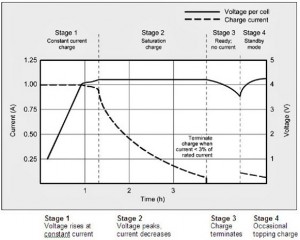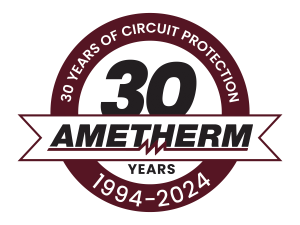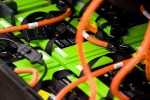
NTC thermistor temperature sensors are a key component in Li-Ion battery charging and safety. They provide critical temperature data required to keep the Li-Ion battery in the optimum condition during the charging cycle. Careful management of temperature during charging prolongs battery life and avoids hazards inherent to Li-Ion batteries.
Li-Ion Batteries Power Green Energy
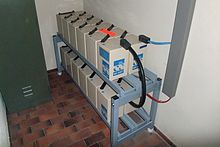
Li-ion Battery – Solar Home Energy Storage
Due to their light weight and high energy density, Li-Ion batteries are used exclusively in consumer electronics. Li-Ion batteries are now replacing lead-acid batteries in high power applications such as Energy Storage Systems (ESS), Photovoltaic Solar Energy (PV) and Electric Powered Vehicles (PEV). Unlike previous battery technologies, Li-Ion batteries do not develop a “memory” if partially charged or discharged and can be completely discharged and recharged hundreds of times with no reduction in performance. This makes them particularly well suited to green energy applications.
Charging Li-Ion Batteries
The Battery University graph illustrates the four distinct stages of Li-Ion battery charging. It shows the current and voltage relationship during the entire charging cycle.
1. Pre-charge Current is held constant while voltage is allowed to rise to a maximum set point.
2. Saturation Voltage is held at the maximum set point and over time, charge current decreases.
3. Ready Charge voltage is turned off when the charge current falls to 3% of the battery’s rated output current.
4. Topping Charge This stage is only required if battery remains in standby mode for an extended period of time.
Charge Balancing, while not one of the Four Charging Stages, is necessary for safe and efficient use of multi-cell Li-ion batteries. Also called Charge Equalization, it assures that each battery cell remains in-step with the others during the charging process.
Limiting Voltage and Current
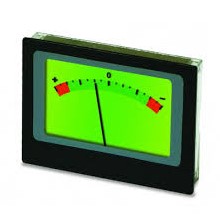
LI-Ion Battery Charging Requires Voltage and Current Limiting
Charging current is limited and charging voltage is allowed to rise during the pre-charge stage. Maximum charging current is determined primarily by the ampere hour rating of the battery. As charging progresses, the increasing voltage is limited at a predetermined set point between 4.1V and 4.3V per cell, depending on the specific Li-Ion battery chemistry.
Earlier nickel-based batteries require a limit of 4.1V per cell, while cobalt, manganese and aluminum battery types can not exceed 4.2V per cell. The highest capacity Li-Ion batteries only charge to 4.3V per cell.
During the saturation stage, voltage is held at these pre-charge maximum set points. Charging current decreases slowly at first, then rapidly. Charging is terminated and the battery is ready to use when charging current falls to 3% of the battery’s ampere hour rating.
A Topping Charge is not the same as trickle-charging. Li-Ion batteries maintain their charge well when idle, with little internal discharge, but may need to be “topped off” after an extended time. Trickle-charging is not recommended.
To assure stability, both voltage and current are carefully controlled during the charging cycle. Of these, controlling charging voltage is most important in managing battery temperature.
Monitoring Battery Temperature
Too low battery temperature will slow the charging rate while too high battery temperature will create a hazard. Maintaining the correct charging temperature range has the added benefit of increasing battery life expectancy.
Li-Ion batteries typically increase 5°C (9°F) in temperature during the 2-3 hours required for charging. This temperature rise is normal and due to the chemical reaction occurring during the charging cycle. To avoid hazard, the battery must not be allowed to increase more than 10°C (18°F) during charging.
The ambient temperature in the immediate environment of the battery contributes heavily to the temperature of the battery during the charging cycle. Heat created by the chemical reaction of charging acts to increase the initial temperature of the battery. The optimum Li-Ion battery temperature range during charging is quite narrow, between 10°C and 30°C (41°F to 86°F). Fast charging, while acceptable, requires that battery temperature not exceed 45°C (113°F). Charging above 45°C (113°F) will degrade battery performance.
Over Temperature Hazard
Over-temperature, whether due to over current, over voltage, high ambient temperature, or any combination of these, can lead to thermal runaway. This is a dangerous condition which can result in a battery fire or even a catastrophic explosion. To avoid thermal runaway, upper safe battery temperatures cannot be exceeded.
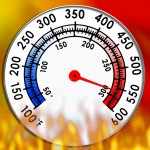
Li-Ion Battery Charging Requires Careful Temperature Control to Avoid Hazards
The upper temperature limit for safe charging must be carefully observed. The battery explosion threshold temperature varies widely depending the specific Li-ion battery chemistry:
- 130°C to 150°C (266°F TO 302°F) – Lithium cobalt oxide, used largely in consumer electronics
- 170°C to 180°C (338°F to 356°F) – Lithium nickel manganese cobalt oxide, used extensively for vehicle use
- 250°C (482°F) – Lithium ion manganese oxide, popular in battery-powered hand tools
A complete shut-down of battery charging voltage is necessary before these temperatures are reached if potential disaster is to be avoided.
Li-Ion Charge Controller
A solution for safe and efficient Li-Ion battery charging has been developed. Precise control of charging current, voltage, and the resulting management of battery temperature, requires that Li-Ion battery chargers employ sophisticated electronic control circuitry. These controllers utilize pre-determined set points and algorithms to adjust charge voltage dynamically. This maintains battery temperature within established safe limits during the entire charging cycle.
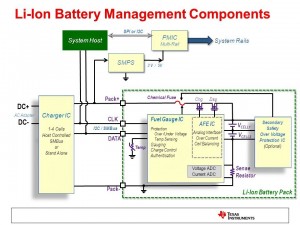
This diagram by Texas Instruments shows components for a Li-Ion Battery Charger. For a multi-cell Lithium-Ion pack, it is important to monitor each individual cell within the pack. Keeping cells in a multi-cell pack in balanced condition is essential. The charging IC regulates the current and voltage to precise levels required for the Lithium Battery.
Often called an ADC, these analog-to-digital controllers employ temperature sensors, physically mounted on the Li-Ion batteries to provide temperature data to the controller. Using this feedback, the controller compensates for high or low battery temperature, excessive ambient temperature, and will stop charging altogether if the battery reaches critically high temperature.
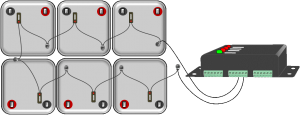
NTC Thermistor Temperature Sensors Monitoring Li-Ion Battery Cell Temperature
In high-power applications, the charge controller requires multiple temperature sensors mounted on the Li-Ion battery. At least one sensor monitors each cell of the battery. NTC thermistors are the sensor of choice to provide temperature feedback to the ADC. The charge controller monitors battery cell temperature individually or collectively depending on the controller type and number of cells in the battery.
The NTC thermistor sensors obtain the necessary temperature readings from direct contact with the battery cell body. Alternatively, temperature sensors are installed on the cell’s electrical terminals to obtain the cell temperature.
Temperature Sensor Selection
As a crucial component in Li-Ion battery charging, the selection of the correct battery temperature sensor is also crucial. Selection of a sensor should consider:
- Accuracy – Tight tolerances necessary for critical temperature measurements
- Reliability – Guaranteed specifications and stable characteristics over time
- Responsiveness – Low thermal time constant providing timely controller feedback
- Durability – Robust service life from quality components and precise manufacturing
Selection of NTC thermistor temperature sensors for the Li-Ion battery may require additional considerations:
- Tolerance not exceeding 5% throughout battery’s anticipated operating temperature range to assure correct measurements
- Battery environment and construction determine whether sensor will be embedded, contact mounted or require a housing
- Appropriate housings can provide easy and secure mounting, effective thermal conduction and protection from physical damage
- High voltage isolation between sensor housing and thermistor output assures safety and operational integrity
Trusted Ametherm NTC Thermistor Sensors
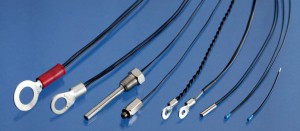
Ametherm NTC Thermistor Temperature Sensors have both electrical and mechanical specifications ideal for use in Li-Ion battery charging applications. The PANR, PANE, DG Glass Encapsulated and ACCU-CURVE Series NTC Thermistor Sensors have been a preferred choice for applications in the Telecommunications, UPS Power and Electric Powered Vehicle Industries.
| Ametherm Part Number | R@25°C | Beta | Dissipation Constant | Thermal Time Constant | Max Power | Order from Digi-Key | Order from Mouser |
|---|---|---|---|---|---|---|---|
| PANR103395 | 10.0kΩ | 3,950°K | 3.0 mW/°C | 40.0sec | 125mW | 570-1402-ND | 995-PANR103395 |
Ametherm NTC Thermistor Temperature Sensors are available in a wide range of R@25°C, Beta and Tolerance values, with several housing types to accommodate most mounting requirements. Visit our authorized online suppliers for NTC Thermistor Temperature Sensor Selection:

